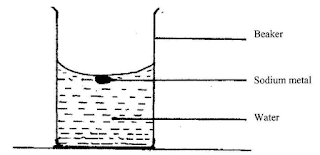BECE 2015 Integrated (Int) Science Paper 2 Essay
BECE PAST QUESTIONS AND ANSWERS
BECE 2015 INTEGRATED SCIENCE
ESSAY - Paper 2
1 ¼ hours
This paper is in two parts: I and II. Answer Question 1 in part I and any other four questions in part II
This paper is in two parts: I and II. Answer Question 1 in part I and any other four questions in part II
PART I (40
marks)
Answer all of Question
1
1. (a)
The diagrams below are illustrations of three different organisms harmful to
farm animals
Study the diagrams carefully and answer the questions that follow
(i) Identify each of the organisms labelled I,
II and III [3
marks]
(ii) Which of the organisms is/are:
(α) parasite(s)
(β) pest(s) [3
marks]
(α) I;
(β) II;
(γ) III. [3
marks]
(iv) State three methods of
controlling the organism labelled III [3
marks]
(b) The diagram below illustrates a burning
candle placed in front of a plane mirror MM′ and an image of the candle
formed in the mirror.
Study the diagram carefully and answer the questions
that follow
(i)
Name the parts labelled I, II, III and
IV [4 marks]
(ii)
State
the relationship between angles θ1 and θ2 [1 mark]
(iii)
Give three characteristics of IV in the diagram [3 marks]
(iv)
Explain why IV is represented in broken lines [2 marks]
(c) In an experiment to investigate the
reactivity of sodium, a piece of sodium metal was dropped in a beaker
containing water. The experimental set-up is as illustrated below.
Study the set-up carefully and answer the questions
that follow
(i)
State what would happen if a glowing
splint was held at the mouth of the beaker [2 marks]
(ii)
Name the gas evolved [1 mark]
(iii)
Write a balanced chemical equation for the reaction that occurred [3 marks]
(iv)
Name two other metals that can react in a similar
way as the sodium [2 marks]
(d)
An experiment to investigate the conditions for germination of viable bean
seeds was carried out. The diagrams below are illustrations of the different
conditions in which the seeds were kept. The beakers labelled A, B and C
containing the seeds were kept at room temperature.
Study the diagrams carefully and answer the questions
that follow
(i)
State what would happen to the seeds
in each of the beakers labelled A, B and C when the
experiment was observed after five days. [3 marks]
(ii) Give reasons for each of your answers in (i) [4 marks]
(ii)
Why was oil spread on the surface of the water in the
beaker labelled C? [2 marks]
PART II (60 marks)
Answer four questions only from this section
2. (a) (i) What
is weather?
(ii) State two differences between weather and
season [4 marks]
(b) State the composition of each
of the following alloys;
(i)
steel;
(iii)
stainless steel [3 marks]
(c.)
List four benefits of vegetables to humans [4 marks]
(d.)
The diagram below is an illustration of life-cycle of
a flowering plant.
Name each of the
stages labelled I, II, III and
IV [4 marks]
3.
(a) Explain how
(i)
lithium atom becomes positively charged
(ii)
oxygen atom becomes
negatively charged [2 marks]
(b)
(i) What is potential energy?
(ii) A coconut of mass 2 kg is on a tree 5 m tall.
Determine the potential energy of the coconut at this height [Take g = 10 ms–2]
[5 marks]
(c.)
State four causes of teenage pregnancy [4 marks]
(d.)
State four uses of soil in agriculture. [4 marks]
4.
(a) Give four health benefits of
water to humans [4 marks]
(b) (i) State two ways in which crop rotation
is important in crop production
(ii) Distinguish between mixed cropping and mixed farming [4 marks]
(c.)
(i) What is a fuse?
(ii) Name the colour code of the wire on which a
fuse is placed in a three-pin plug
[3 marks]
(d.)
(i) In a
tabular form, state three differences between osmosis and diffusion
(ii) State one way in which osmosis is
similar to diffusion [4
marks]
5.
(a) (i) What is a balanced ration in animal nutrition?
(ii) State two benefits of balanced
ration to poultry [4
marks]
(b)
List four hazards that may be encountered in
teaching and learning of science [4 marks]
(c.)
Name the parts of the circulatory system of humans [3 marks]
(d.) (i) What is a simple machine?
(ii)
State two methods of overcoming friction in everyday
activities [4 marks]
6.
(a) (i) What is a magnetic field?
(ii) To which class of mixture does each of
the following belong?
(α) Smoke
(β)
Air
(γ) Bronze [5 marks]
(b) (i) What
is plaque in human dentition?
You Might Also Like
rme - bece 2019 Paper 1
rme - bece 2009 rme
maths bece past questions - 2013 Maths Paper 1
maths bece past questions - 2018 maths paper 1
maths bece past questions - 2012 maths paper 1
bece past questions 2015 - Social studies paper 1
bece past questions - Social studies paper 2
bece past questions 2015 - Maths
bece past questions 2015 - English Paper 1
bece past questions pdf - Maths
bece 2017 questions and answers - RME Paper 1
bece 2017 questions and answers - Integrated Science Paper 2
bece 2017 questions and answers - Maths Paper 2
bece 2017 questions and answers - Social Studies paper 2







.webp)








No comments: